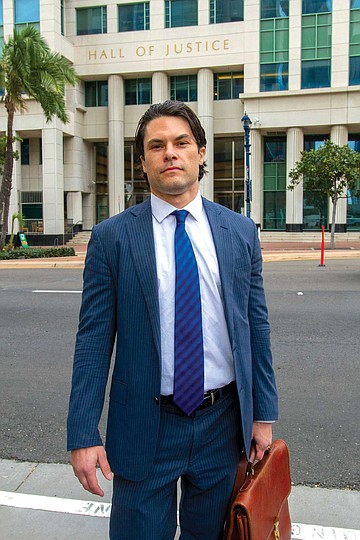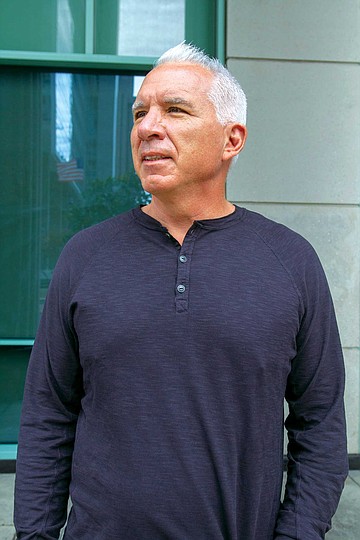 Facebook
Facebook
 X
X
 Instagram
Instagram
 TikTok
TikTok
 Youtube
Youtube

Arguably, it was incidental that a San Diego courtroom proved to be the venue where federal judicial power asserted that enough was enough in terms of Donald Trump’s child-separation policy — a decision that helped pave the way for massive settlement negotiations between the Justice Department and the immigrant families that had been affected. But for some, it no doubt seemed significant, because local governments in and around San Diego have, of late, been making some historically large legal-liability settlements.

One notable example: in September of last year, a $10 million award was issued to the family of two young men who died when their car exploded after an off-duty San Diego police officer’s city-issued Ford Explorer “Interceptor” slammed into their Toyota Corolla. In 2018, Jesus David Dominguez, his sister Giovanna, and Isaac Felix were driving at night on the 15 when they were hit by previously convicted drunk driver Jeffrey Brian Levi. According to Levi’s defense attorney, the collision left them stranded and without working lights, but uninjured. What killed Jesus and Isaac (and severely injured Giovanna) was the high-speed impact from SDPD gang-unit officer Detective Sergeant Raymond Rowe’s SUV just minutes later. Because of Levi’s previous DUI conviction, the prosecutor in his case argued that he was “on notice” with regard to the dangers of drunken driving, and he was convicted of murder and sentenced to 34 years to life in prison. Detective Rowe, meanwhile, blamed his bad vision, his failure to wear driving glasses, and the Corolla’s lack of lights, and noted, “I didn’t actually see the collision, I felt it. I was looking in the rear-view mirror.”
Ten million dollars is a lot of money. But attorney Warren Ellis, who represented the Dominguez and Felix families, warns against a knee-jerk reaction: “I always say the worst thing that can happen to a person or to a family is to receive a large liability settlement, because it means something very, very bad has happened to them. It’s a fact that municipal governments and insurance companies are not in the business of giving out big settlements willy-nilly.” Context, he says, is everything. “There’s this misperception among the public that, ‘Hey, these people are going to suddenly be made very wealthy because of a mere car accident.’ They don’t realize where the damages are really going.”
He starts by pointing to medical expenses for the survivor: “Giovanna had third-degree burns over 25 percent of her body surface,” and longterm medical recovery will be a fact of life for the young woman for many years. Then he notes that the men who died were young — 33 and 19 — two lifetimes cut short. Further, there were children left behind, children who lost a provider. Finally, he says that payouts are generally split among multiple parties, and that they generally come via structured disbursements from insurance companies and multi-jurisdictional sources across decades. That, he explains, is why taxpayers don’t usually take big, concentrated hits, even from settlements such as the one he recently secured.
Suicides and Supervisors
The Rowe crash was an awful, isolated incident. Other recent payouts indicate troubling patterns, such as those related to a rash of suicides among people inside lock-ups operated by the San Diego County Sheriff’s Department. On May 11, 2020, deeply depressed Joseph “Joey” Morton was being held in the sheriff’s Vista Detention Facility for erratic behavior that included an amateurish attempt at robbery using a toy gun. Morton was broke, and after getting laid off from his job at the beginning of the pandemic, he saw no way to make a living. Just the day before, he had been released from a so-called “5150” hold after a neighbor had called 911 and authorities had found him attempting suicide by inhaling carbon monoxide fumes. (Morton was already unconscious when authorities found him, according to court documents.) As the Reader reported in December, “While detained at Vista Detention Facility, on three different occasions, Joey admitted to medical staff that he was feeling suicidal and was suffering from untreated mental health disorders and withdrawals.” And every time, says Morton family attorney Danielle Pena, an outsourced medical provider “ignored his admissions because they thought he was lying.” The Mortons are now suing the county.
Citing research in a 2020 article published in the professional-trade periodical Prison Legal News, the complaint against San Diego County and other defendants in the Morton case states, “The county has the dubious distinction of leading the state in prisoner suicides, with a 10-year average of 74.8 suicides per 100,000, compared to Los Angeles’ 44.3 per 100,000.” The complaint notes that a “2018 report by the nonprofit Disability Rights Organization blamed an over-reliance on incarceration for the mentally ill as well as a failure to provide adequate mental-health care to those in custody. ‘Effective suicide prevention practices and oversight are especially lacking, [the Disability Rights Organization] found.’”
The complaint further asserts that San Diego County supervisors are on the record as having said to a Joint Legislative Audit Committee that “there is an extensive public record documenting the tragic loss of lives, systemic failures, and inadequacy of oversight... This grim history shows no sign of waning.” Furthermore, the complaint claims that “as a direct result of the county’s abysmal suicide rate, and likely the root cause of the suicide rate, members of the board of supervisors have publicly criticized Sheriff Bill Gore for maintaining knowingly inadequate policies and procedures, and primarily for outsourcing medical and mental-health care.” The Morton attorneys are seeking a jury trial, and asking for unspecified damages on four major counts, ranging from “objective indifference” and medical malpractice, to inadequate care-in-custody policies, gross negligence, and wrongful death.

The San Diego County Board of Supervisors is already worried about alleged negligence leading to suicide among jailed individuals. One reason: the cost of paying for not taking such risks seriously. In September, the same downtown San Diego firm where Pena practices secured an historic settlement from the county for a strikingly similar case: that of Heron Moriarty, who died by suicide at the Vista lockup. Moriarty’s family received a record payout of of nearly $3 million after the deceased man’s wife (now his widow) begged medical staff and jailers to watch out for the likelihood that her husband would try to take his own life in jail.
Morris Law Firm founder (and former deputy city attorney) Christopher Morris says, “To me, being a public official requires one to not only assess the fiscal impact of the decision being made, but in my opinion, our leaders have a responsibility to resolve cases of clear liability early on in the process for the sake of the aggrieved party. They really have a dual duty — a fiscal responsibility to the public and a moral obligation to the aggrieved. In my opinion, [significant liability settlements and judgements are] the most effective deterrent to bad public policies and negligent conduct by government employees. The old saying that ‘money talks’ is especially true in this context.”
The board of supervisors may agree. In addition to yielding a $2.95 million payout to the 43-year-old electrical contractor’s widow — the most ever paid to a civil litigant by the county in a jail-suicide case — Heron Moriarity’s death and the ensuing lawsuit prompted a state audit of how the county handles people with mental health problems while they are in custody. It seems there is plenty of blame to go around. Notes the audit, “The [Citizens Law Enforcement Review Board] has not independently interviewed witnesses or visited the initial scenes of the deaths. Further, it has not consistently performed thorough investigations, and it relies largely on the interviews the Sheriff’s Department conducts. Moreover, [the Board] failed to review dozens of deaths in the Sheriff’s Department’s jails.” It seems there is still a long way to go.
Smash silos, stop stumbles?
Speaking of audits: a 2020 City of San Diego audit informed elected leaders that a “siloed” warren of municipal departments doesn’t bode well when it comes to coordinating and communicating regarding mitigation of liability-lawsuit risks. Damaged sidewalks are a perfect example. According to a city-generated report on the audit, “The City incurs liability for a wide variety of issues, such as when a resident trips on a damaged City sidewalk and falls.” The report adds that resources useful for eliminating some of the millions of dollars in liability payouts caused by cracked concrete may be buried inside City Hall’s own databases. “The City’s approach to trip and fall risk mitigation does not utilize data analytics to identify trends in the locations of trip and fall claims, and does not sufficiently prioritize sidewalk defect repairs in areas where future claims are most likely to occur. One likely result is that both the annual number of trip and fall closed claims and costs trended upward during [fiscal years 2010 to 2018].” The sidewalks portion of the audit analysis concluded that “overall, the City closed 875 trip-and-fall claims and incurred approximately $14.6 million in trip and fall claim costs during [fiscal year] 2010 to [fiscal year] 2018.”
Bad cop, good insurance
San Diego Police Detective Daniel Riis’s decision in 2018 to pepper spray Gregory McNally and slam his head to the ground at a Fashion Valley trolley platform cost the city the hefty sum of $2.5 million in damages and legal costs. (It took just a week-long trial for a jury to conclude McNally had been wronged by the city’s police department.) But according to a researcher at the UCLA School of Law, there’s doubt about whether large liability judgements and payouts do all that much to deter city employees from making high-cost mistakes. “Some law enforcement agencies pay millions from their budgets each year toward settlements and judgments, but the particularities of their jurisdictions’ budgeting arrangements lessen or eliminate altogether the financial impact of these payments on these agencies,” writes UCLA law Professor Joanna C. Schwartz.

It seems she has a point: the McNally case was only one in a bucket of 20,000 claims with liability payouts that, for the city of San Diego alone, totaled $220 million during a recent eight-year period. But it turns out large municipalities like the city and the county of San Diego are actually pretty good at managing their litigation liabilities. Even though its own auditors say there’s major room for improving liability-risk mitigation through better data-sharing and communication, the city reports receiving far more in insurance-claims proceeds — that means income — than it pays out in both premiums and its share of claims. Citing analyses by the city’s Risk Management Department, auditors reported to the mayor and city council that San Diegans “paid approximately $45 million for public liability insurance and received over $120 million in insurance proceeds” from 2014 to 2018. San Diego pulls off this near-magical trick by maintaining a complex, but apparently effective, set of long-established practices that include pool-buying of insurance policies, “self-insurance,” re-insurance and joint-powers cost-sharing with other regional governments.
Keeping premiums lower than proceeds despite a constant flow of civil rights, negligence, and other liability lawsuits would be impossible for an individual or small business. But large corporations, states, and municipal governments have a lot more options when it comes to fiscal strategies and mitigating the costs of their legal liabilities. Prowess in shielding taxpayers — i.e., voters — from the pain of large liability payouts means that most elected officials rarely feel repercussions at the ballot box as a result of being sued over reckless employees or harmful policies.


Arguably, it was incidental that a San Diego courtroom proved to be the venue where federal judicial power asserted that enough was enough in terms of Donald Trump’s child-separation policy — a decision that helped pave the way for massive settlement negotiations between the Justice Department and the immigrant families that had been affected. But for some, it no doubt seemed significant, because local governments in and around San Diego have, of late, been making some historically large legal-liability settlements.

One notable example: in September of last year, a $10 million award was issued to the family of two young men who died when their car exploded after an off-duty San Diego police officer’s city-issued Ford Explorer “Interceptor” slammed into their Toyota Corolla. In 2018, Jesus David Dominguez, his sister Giovanna, and Isaac Felix were driving at night on the 15 when they were hit by previously convicted drunk driver Jeffrey Brian Levi. According to Levi’s defense attorney, the collision left them stranded and without working lights, but uninjured. What killed Jesus and Isaac (and severely injured Giovanna) was the high-speed impact from SDPD gang-unit officer Detective Sergeant Raymond Rowe’s SUV just minutes later. Because of Levi’s previous DUI conviction, the prosecutor in his case argued that he was “on notice” with regard to the dangers of drunken driving, and he was convicted of murder and sentenced to 34 years to life in prison. Detective Rowe, meanwhile, blamed his bad vision, his failure to wear driving glasses, and the Corolla’s lack of lights, and noted, “I didn’t actually see the collision, I felt it. I was looking in the rear-view mirror.”
Ten million dollars is a lot of money. But attorney Warren Ellis, who represented the Dominguez and Felix families, warns against a knee-jerk reaction: “I always say the worst thing that can happen to a person or to a family is to receive a large liability settlement, because it means something very, very bad has happened to them. It’s a fact that municipal governments and insurance companies are not in the business of giving out big settlements willy-nilly.” Context, he says, is everything. “There’s this misperception among the public that, ‘Hey, these people are going to suddenly be made very wealthy because of a mere car accident.’ They don’t realize where the damages are really going.”
He starts by pointing to medical expenses for the survivor: “Giovanna had third-degree burns over 25 percent of her body surface,” and longterm medical recovery will be a fact of life for the young woman for many years. Then he notes that the men who died were young — 33 and 19 — two lifetimes cut short. Further, there were children left behind, children who lost a provider. Finally, he says that payouts are generally split among multiple parties, and that they generally come via structured disbursements from insurance companies and multi-jurisdictional sources across decades. That, he explains, is why taxpayers don’t usually take big, concentrated hits, even from settlements such as the one he recently secured.
Suicides and Supervisors
The Rowe crash was an awful, isolated incident. Other recent payouts indicate troubling patterns, such as those related to a rash of suicides among people inside lock-ups operated by the San Diego County Sheriff’s Department. On May 11, 2020, deeply depressed Joseph “Joey” Morton was being held in the sheriff’s Vista Detention Facility for erratic behavior that included an amateurish attempt at robbery using a toy gun. Morton was broke, and after getting laid off from his job at the beginning of the pandemic, he saw no way to make a living. Just the day before, he had been released from a so-called “5150” hold after a neighbor had called 911 and authorities had found him attempting suicide by inhaling carbon monoxide fumes. (Morton was already unconscious when authorities found him, according to court documents.) As the Reader reported in December, “While detained at Vista Detention Facility, on three different occasions, Joey admitted to medical staff that he was feeling suicidal and was suffering from untreated mental health disorders and withdrawals.” And every time, says Morton family attorney Danielle Pena, an outsourced medical provider “ignored his admissions because they thought he was lying.” The Mortons are now suing the county.
Citing research in a 2020 article published in the professional-trade periodical Prison Legal News, the complaint against San Diego County and other defendants in the Morton case states, “The county has the dubious distinction of leading the state in prisoner suicides, with a 10-year average of 74.8 suicides per 100,000, compared to Los Angeles’ 44.3 per 100,000.” The complaint notes that a “2018 report by the nonprofit Disability Rights Organization blamed an over-reliance on incarceration for the mentally ill as well as a failure to provide adequate mental-health care to those in custody. ‘Effective suicide prevention practices and oversight are especially lacking, [the Disability Rights Organization] found.’”
The complaint further asserts that San Diego County supervisors are on the record as having said to a Joint Legislative Audit Committee that “there is an extensive public record documenting the tragic loss of lives, systemic failures, and inadequacy of oversight... This grim history shows no sign of waning.” Furthermore, the complaint claims that “as a direct result of the county’s abysmal suicide rate, and likely the root cause of the suicide rate, members of the board of supervisors have publicly criticized Sheriff Bill Gore for maintaining knowingly inadequate policies and procedures, and primarily for outsourcing medical and mental-health care.” The Morton attorneys are seeking a jury trial, and asking for unspecified damages on four major counts, ranging from “objective indifference” and medical malpractice, to inadequate care-in-custody policies, gross negligence, and wrongful death.

The San Diego County Board of Supervisors is already worried about alleged negligence leading to suicide among jailed individuals. One reason: the cost of paying for not taking such risks seriously. In September, the same downtown San Diego firm where Pena practices secured an historic settlement from the county for a strikingly similar case: that of Heron Moriarty, who died by suicide at the Vista lockup. Moriarty’s family received a record payout of of nearly $3 million after the deceased man’s wife (now his widow) begged medical staff and jailers to watch out for the likelihood that her husband would try to take his own life in jail.
Morris Law Firm founder (and former deputy city attorney) Christopher Morris says, “To me, being a public official requires one to not only assess the fiscal impact of the decision being made, but in my opinion, our leaders have a responsibility to resolve cases of clear liability early on in the process for the sake of the aggrieved party. They really have a dual duty — a fiscal responsibility to the public and a moral obligation to the aggrieved. In my opinion, [significant liability settlements and judgements are] the most effective deterrent to bad public policies and negligent conduct by government employees. The old saying that ‘money talks’ is especially true in this context.”
The board of supervisors may agree. In addition to yielding a $2.95 million payout to the 43-year-old electrical contractor’s widow — the most ever paid to a civil litigant by the county in a jail-suicide case — Heron Moriarity’s death and the ensuing lawsuit prompted a state audit of how the county handles people with mental health problems while they are in custody. It seems there is plenty of blame to go around. Notes the audit, “The [Citizens Law Enforcement Review Board] has not independently interviewed witnesses or visited the initial scenes of the deaths. Further, it has not consistently performed thorough investigations, and it relies largely on the interviews the Sheriff’s Department conducts. Moreover, [the Board] failed to review dozens of deaths in the Sheriff’s Department’s jails.” It seems there is still a long way to go.
Smash silos, stop stumbles?
Speaking of audits: a 2020 City of San Diego audit informed elected leaders that a “siloed” warren of municipal departments doesn’t bode well when it comes to coordinating and communicating regarding mitigation of liability-lawsuit risks. Damaged sidewalks are a perfect example. According to a city-generated report on the audit, “The City incurs liability for a wide variety of issues, such as when a resident trips on a damaged City sidewalk and falls.” The report adds that resources useful for eliminating some of the millions of dollars in liability payouts caused by cracked concrete may be buried inside City Hall’s own databases. “The City’s approach to trip and fall risk mitigation does not utilize data analytics to identify trends in the locations of trip and fall claims, and does not sufficiently prioritize sidewalk defect repairs in areas where future claims are most likely to occur. One likely result is that both the annual number of trip and fall closed claims and costs trended upward during [fiscal years 2010 to 2018].” The sidewalks portion of the audit analysis concluded that “overall, the City closed 875 trip-and-fall claims and incurred approximately $14.6 million in trip and fall claim costs during [fiscal year] 2010 to [fiscal year] 2018.”
Bad cop, good insurance
San Diego Police Detective Daniel Riis’s decision in 2018 to pepper spray Gregory McNally and slam his head to the ground at a Fashion Valley trolley platform cost the city the hefty sum of $2.5 million in damages and legal costs. (It took just a week-long trial for a jury to conclude McNally had been wronged by the city’s police department.) But according to a researcher at the UCLA School of Law, there’s doubt about whether large liability judgements and payouts do all that much to deter city employees from making high-cost mistakes. “Some law enforcement agencies pay millions from their budgets each year toward settlements and judgments, but the particularities of their jurisdictions’ budgeting arrangements lessen or eliminate altogether the financial impact of these payments on these agencies,” writes UCLA law Professor Joanna C. Schwartz.

It seems she has a point: the McNally case was only one in a bucket of 20,000 claims with liability payouts that, for the city of San Diego alone, totaled $220 million during a recent eight-year period. But it turns out large municipalities like the city and the county of San Diego are actually pretty good at managing their litigation liabilities. Even though its own auditors say there’s major room for improving liability-risk mitigation through better data-sharing and communication, the city reports receiving far more in insurance-claims proceeds — that means income — than it pays out in both premiums and its share of claims. Citing analyses by the city’s Risk Management Department, auditors reported to the mayor and city council that San Diegans “paid approximately $45 million for public liability insurance and received over $120 million in insurance proceeds” from 2014 to 2018. San Diego pulls off this near-magical trick by maintaining a complex, but apparently effective, set of long-established practices that include pool-buying of insurance policies, “self-insurance,” re-insurance and joint-powers cost-sharing with other regional governments.
Keeping premiums lower than proceeds despite a constant flow of civil rights, negligence, and other liability lawsuits would be impossible for an individual or small business. But large corporations, states, and municipal governments have a lot more options when it comes to fiscal strategies and mitigating the costs of their legal liabilities. Prowess in shielding taxpayers — i.e., voters — from the pain of large liability payouts means that most elected officials rarely feel repercussions at the ballot box as a result of being sued over reckless employees or harmful policies.
Comments